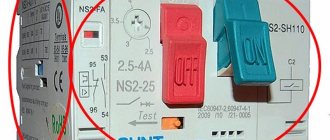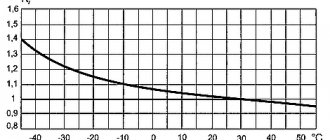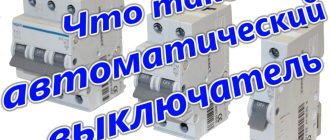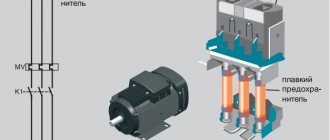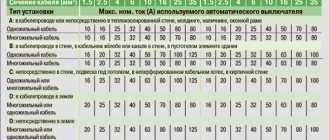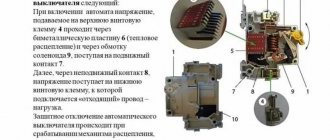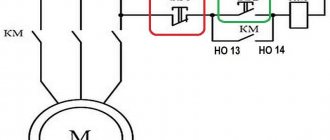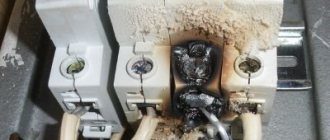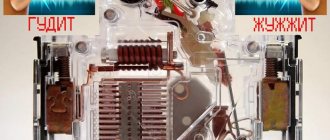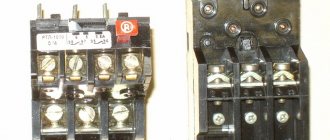When selecting circuit breakers that can protect electric motors from damage as a result of short circuits or excessively high loads, it is necessary to take into account the large value of the starting current, often 5-7 times higher than the nominal value. Asynchronous power units with a squirrel-cage rotor are subject to the most powerful starting overloads. Since this equipment is widely used for work in industrial and domestic conditions, the issue of protecting both the device itself and the power cable is very relevant. This article will discuss how to correctly calculate and select a motor protection circuit breaker.
Tasks of devices for protecting electric motors
Household electrical equipment is usually protected from large inrush currents in networks using three-phase circuit breakers that operate some time after the current exceeds the rated value. Thus, the motor shaft has time to spin up to the desired rotation speed, after which the force of the electron flow decreases. But the protective devices used in everyday life do not have precise settings. Therefore, the choice of a circuit breaker that allows you to protect an asynchronous motor from overloads and short-circuit overcurrents is more complicated.
Modern motor protection circuit breakers are often installed in a common housing with starters (the so-called motor starting switching devices). They are designed to perform the following tasks:
- Protecting the device from overcurrent occurring inside the motor or in the power supply circuit.
- Protection of the power unit from phase conductor breakage, as well as phase imbalance.
- Providing a time delay that is necessary so that the motor, which is forced to stop as a result of overheating, has time to cool down.
Control and protective automation for the engine on video:
- Shutting down the installation if the load is no longer supplied to the shaft.
- Protection of the power unit from long overloads.
- Protection of the electric motor from overheating (to perform this function, additional temperature sensors are mounted inside the unit or on its body).
- Indication of operating modes, as well as notification of emergency conditions.
It is also necessary to take into account that the circuit breaker for protecting the electric motor must be compatible with control and control mechanisms.
Circuit breaker parameters
The correct selection of the rating is necessary. The function of the circuit breaker is to protect the electrical wiring before the current exceeds the permissible value. This means that the current circuit breaker is always selected to be less than the permissible long-term current of the electrical wiring.
Therefore, the algorithm for selecting a circuit breaker comes down to the following actions:
- First of all, you should calculate the thickness of the wire for a specific area, depending on the load.
- The table shows how much current the wires can withstand, depending on the cross-section.
- Of all the available ratings of the machines, the one closest in parameters, but less than the load capacity of the wires, is selected. The ratings of the machines are tied to the long-term permissible current of wires and cables.
As an example
The selection algorithm is not associated with any difficulties and works effectively. Below is a table that shows the maximum values of electric current for conductors that are laid in houses or apartments. In the same table, in a separate column, machines with a rated operating current are indicated, which are recommended for use in circuits of such conductors. To ensure that the electrical wiring does not overheat and operates normally, machines with operating current values that are less than the permissible values of the operating current of the electrical wiring are selected.
First you need to select the wire cross-section. It is selected according to calculations based on the load size. For example, to power one of the loads, according to calculations, you need to take a conductor with a cross-section of 2.5 mm square. The table shows that this conductor can easily withstand currents of up to 27 amperes. Here you can see that to protect this conductor, you should install a machine with an operating current of 16 A.
The circuit works as follows: until 16 amperes are reached, the machine operates normally, as does the electrical wiring. If the current begins to increase to a certain value, the circuit breaker begins to respond to it. The thermal protection starts working. The more the operating current of the machine is exceeded, the faster the protection will operate. In the event of a short circuit in the network, the circuit breaker is switched off instantly, since short circuit protection and thermal protection operate on different principles.
How to calculate consumer power
As a rule, the characteristics of circuit breakers are selected depending on the load power. It is easier to make calculations if only one electrical appliance is connected to the electrical line. As a rule, powerful household appliances are connected to one line, and their power consumption is always indicated in the passport. It is more difficult with lines to which various household appliances are connected from time to time, for example, vacuum cleaners, electric irons, food processors, etc.
But if we take into account that their operation is short-term, then the electrical wiring is selected depending on how many of these devices can operate simultaneously. As for the input machine, it is selected depending on the total power of all consumers. You can use a simple formula, or you can use the data specified in the passport. As a rule, the passport indicates not only the power of the electrical appliance, but also its actual operating current.
Formula for calculating consumer power
After the magnitude of the loads has been determined, the appropriate circuit breaker for the operating current is selected. Its rating may be much less or a little more, but in any case it must protect the electrical wiring and its performance should not be overestimated in relation to the permissible current of the electrical wires.
As a rule, they try to choose electrical wires with a reserve, although even here reasonable limits should be adhered to. In this case, the machines are selected according to the load current and also with a margin, although also within reasonable limits. The machine must always withstand the load current, with some margin, or the operation of the devices will be unstable and the machine can turn off such a load at any time, which is completely wrong.
Calculation of an automatic machine for an electric motor
Until recently, the following scheme was used to protect electric motors: a thermal regulator was installed inside the starter, connected in series with the contactor. This mechanism worked like this. When a large current passed through the relay for a long time, the bimetallic plate installed in it was heated, which, bending, interrupted the contactor circuit. If the excess of the set load was short-term (as happens when starting the engine), the plate did not have time to heat up and trigger the machine.
Internal structure of the motor protection circuit breaker in the video:
The main disadvantage of this scheme was that it did not save the unit from voltage surges, as well as phase imbalance. Nowadays, the protection of electric power plants is provided by more accurate and modern devices, which we will talk about a little later. Now let’s move on to the question of how to calculate the machine that needs to be installed in the electric motor circuit.
To select a protective circuit breaker for an electrical installation, you need to know its time-current characteristics, as well as its category. The time-current characteristic does not depend on the rated current for which the AV is designed.
To prevent the circuit breaker from tripping every time the motor is started, the value of the starting current should not be greater than that which causes the device to immediately operate (cut-off). The ratio of the starting current and the nominal value is specified in the equipment passport, the maximum allowable is 7/1.
When calculating the machine practically, you should use the reliability coefficient, denoted by the symbol Kn. If the rated current of the device does not exceed 100A, then the value of Kn is 1.4; for larger values it is 1.25. Based on this, the value of the cut-off current is determined by the formula Iots ≥ Kn x Istart. We select the circuit breaker in accordance with the calculated parameters.
Another value that must be taken into account when selecting when the machine is mounted in an electrical panel or a special cabinet is the temperature coefficient (CT). This value is 0.85, and the rated current of the protective device should be multiplied by it when selecting (In/Kt).
Disadvantages and scope of application of the contactor
The contactor had the following disadvantages for us:
- With a reduced control voltage of 220V, the contacts diverge and an arc forms, which leads to burnout or sticking of the contacts.
- Makes sounds (buzzing).
- It's getting warm.
- Constantly consumes electricity.
Contactors are good for frequently turning on/off powerful loads (pumps, boilers, etc.), but if you need to turn something on rarely and for a long time (we can turn on a house and turn it off only after a few months), then it is better to use something like this equipment - motor drive.
And as always, we decided to test the motor drive for EKF AV-M1 circuit breakers and, if successful, offer it to our neighbors.
The motor drive operates only as part of EKF automatic machines and RCDs of the AVERES series.
Modern electrical protection devices for power units
Modular automatic motors, which are universal devices that successfully cope with all the functions described above, are very popular.
In addition, they can be used to adjust shutdown parameters with high accuracy.
Modern automatic motors come in many varieties, differing from each other in appearance, characteristics and control method. As when selecting a conventional device, you need to know the value of the starting current, as well as the rated current. In addition, it is necessary to decide what functions the protective device should perform. Having made the necessary calculations, you can buy an automatic motor. The price of these devices directly depends on their capabilities and the power of the electric motor.
Circuit breakers
Anyone who has dealt with electrical wiring has heard about circuit breakers or circuit breakers.
First of all, a competent electrician will always advise you to treat the choice of such an important part of the electrical network with particular scrupulousness. Since later this simple device can save you from many troubles
It doesn’t matter at all what type of electrical installation work is being carried out - whether new wiring is being installed in a newly built house, the old one is being replaced, the panel is being modernized, or a separate branch is being laid for too energy-intensive devices - in any case, special attention must be paid to the selection of the machine according to power and other parameters
Purpose of the device
Any modern machine has two degrees of protection. This means that he will be able to help in the two most common situations.
- The first implies overheating of the wiring as a result of the passage of currents through it that are greater than the rated ones. It’s easy to guess what this can lead to: a cable burnout, and ultimately a short circuit or even a fire.
- The second situation that a circuit breaker can prevent is a short circuit, as a result of which the current strength in the circuit can increase by enormous values, and this can, at best, lead to the failure of all electrical equipment. At worst, it could result in a fire of electrical equipment, and from it the entire room. There is no need to talk about the integrity of the wiring at all.
Thus, the machine is capable of protecting not only personal property, but in some cases, life. Although for this it is necessary to carry out a competent calculation of the circuit breaker in terms of power and a number of other parameters. And also, you should not take the machine “with a reserve”, since at critical values of currents in the network it may simply not work, which is equivalent to its absence.
Principle of operation
The main task of the safety switch is to cut off the supply of electric current from the supply cable to the consumer's network. This happens thanks to the releases located in the body of the machine. Moreover, there are two types of such parts:
- Electromagnetic, which consists of a coil, a spring and a core, which, when the rated currents are exceeded, is retracted and through the spring disconnects the contacts. This happens almost instantly - from 0.01 to 0.001 seconds, which can provide reliable protection.
- Bimetallic thermal - triggered by the passage of currents exceeding the limit values. In this case, the bimetallic plate, which is the basis of such a release, bends and the contacts break.
Types of ABs and their features
Given the variety of electrical networks and certain situations, machines can be of different types. The principle of their operation is no different in any significant way - the same releases are triggered, but depending on the situation and a number of other nuances, different variations are used.
Thus, for a standard single-phase network with a voltage of 220 volts, single-pole and two-pole AVs are produced. The former are capable of breaking only one wire - a phase. The latter can work with both phase and zero. Of course, it is preferable to use the second option. Especially when it comes to rooms with high humidity. Of course, a single-pole circuit breaker will cope with its task, but situations may arise when burnt-out wires are short-circuited. In this case, naturally, the phase will be cut off, but the neutral wire will be energized, which can be extremely dangerous.
For three-phase networks with a voltage of 380 volts, three- or four-pole circuit breakers are used. They must be installed both at the entrance and directly in front of the consumer. As is clear, such machines cut off all three phases connected to them. In rare cases, it is possible to use one- or two-pole protective devices to cut off one or two phases, respectively.
Features of protection of electric motors in industrial conditions
Often, when turning on devices whose power exceeds 100 kW, the voltage in the general network drops below the minimum. In this case, the working power units are not switched off, but their speed is reduced. When the voltage is restored to normal levels, the motor begins to gain speed again. In this case, its operation occurs in overload mode. This is called self-starting.
Self-starting sometimes causes false alarms. This can happen when, before the temporary voltage drop, the installation had been operating in normal mode for a long time, and the bimetallic plate had time to warm up. In this case, the thermal release sometimes trips before the voltage returns to normal. An example of a voltage drop in a car's electrical network in the following video:
To prevent the shutdown of powerful factory electric motors during self-starting, relay protection is used, in which current transformers are connected to the general network. Protective relays are connected to their secondary windings. These systems are selected using complex calculations. We will not present them here, since in production this task is performed by full-time power engineers.
Deciding on the denomination
Actually, from the functions of the circuit breaker, the rule for determining the rating of the circuit breaker follows: it must operate until the current exceeds the capabilities of the wiring. This means that the current rating of the machine must be less than the maximum current that the wiring can withstand.
For each line you need to choose the right circuit breaker
Based on this, the algorithm for selecting a circuit breaker is simple:
- Calculate the wiring cross-section for a specific area.
- See what maximum current this cable can withstand (see the table).
- Next, from all the ratings of the circuit breakers, we select the nearest smaller one. The ratings of the machines are tied to the permissible long-term load currents for a particular cable - they have a slightly lower rating (see the table). The list of denominations looks like this: 16 A, 25 A, 32 A, 40 A, 63 A. From this list you choose the appropriate one. There are smaller values, but they are practically not used anymore - we have too many electrical appliances and they have considerable power.
Example
The algorithm is very simple, but it works flawlessly. To make it clearer, let's look at an example. Below is a table that shows the maximum permissible current for conductors that are used when laying wiring in a house and apartment. Recommendations regarding the use of machines are also given there. They are given in the column “Nominal current of the circuit breaker”. This is where we look for the ratings - it is slightly less than the maximum permissible for the wiring to work normally.
| Cross section of copper wires | Permissible continuous load current | Maximum load power for single-phase network 220 V | Rated current of circuit breaker | Circuit breaker current limit | Approximate load for single-phase circuit |
| 1.5 sq. mm | 19 A | 4.1 kW | 10 A | 16 A | lighting and alarm |
| 2.5 sq. mm | 27 A | 5.9 kW | 16 A | 25 A | socket groups and electric heated floor |
| 4 sq.mm | 38 A | 8.3 kW | 25 A | 32 A | air conditioners and water heaters |
| 6 sq.mm | 46 A | 10.1 kW | 32 A | 40 A | electric stoves and ovens |
| 10 sq. mm | 70 A | 15.4 kW | 50 A | 63 A | opening lines |
In the table we find the selected wire cross-section for this line. Suppose we need to lay a cable with a cross-section of 2.5 mm2 (the most common when laying to medium-power devices). A conductor with this cross-section can withstand a current of 27 A, and the recommended rating of the machine is 16 A.
How will the circuit work then? As long as the current does not exceed 25 A, the machine does not turn off, everything works as normal - the conductor heats up, but not to critical values. When the load current begins to increase and exceeds 25 A, the machine does not turn off for some time - perhaps these are starting currents and they are short-lived. It turns off if the current exceeds 25 A by 13% for a sufficiently long time. In this case, if it reaches 28.25 A. Then the power supply will work and de-energize the branch, since this current already poses a threat to the conductor and its insulation.
Power calculation
Is it possible to choose a machine based on load power? If only one device is connected to the power line (usually large household appliances with high power consumption), then it is permissible to make a calculation based on the power of this equipment. You can also choose an introductory machine based on power, which is installed at the entrance to a house or apartment.
If we are looking for the rating of the input circuit breaker, we need to add up the power of all devices that will be connected to the home network. Then the found total power is substituted into the formula, and the operating current for this load is found.
Formula for calculating current from total power
After we have found the current, select the value. It may be either slightly more or slightly less than the found value. The main thing is that its shutdown current does not exceed the maximum permissible current for this wiring.
When can you use this method? If the wiring is laid with a large margin (this is not bad, by the way). Then, in order to save money, you can automatically install switches corresponding to the load, and not the cross-section of the conductors
But once again we draw your attention to the fact that the long-term permissible current for the load must be greater than the maximum current of the circuit breaker. Only then will the choice of circuit breaker be correct
Operating principle
After connecting the power and load electrical lines to the three-phase circuit breaker, it is turned on by moving the lever to the upper position. As a result, the lever engages through the latch with the switching contact. The formed connection is ensured by the displacement of the movable contact group relative to their holder.
In a normal situation, current passes through the contact between the power and moving contacts. Then it goes to the bimetallic plate and the solenoid winding, and from it it goes to the terminal and the load connected to the machine.
If a current begins to flow through the switch with a value exceeding the permissible value, then the bimetallic plate begins to heat up. Due to the different thermal expansion of the metals, it bends, eventually breaking the contact. The current strength at which the connection breaks depends on the thickness of the plate. The thermomagnetic release is characterized by slow operation, although it can detect even small changes in the current value. Its setting is carried out at the factory by changing the distance between the plate and the moving contact. An adjusting screw is used for this.
But for a current that instantly increases its value, the reaction rate of the bimetallic plate will be extremely low, so a solenoid is used along with it. In the normal state, the core is pushed out by the spring and closes the contact of the machine. When the signal value is abnormal, the magnetic field rapidly increases in the coil turns, the flows of which draw the core inward, overcoming the action of the spring, and this leads to a break in the circuit.
The operation of the electromagnetic release occurs in a fraction of a second, while it does not respond to currents slightly exceeding the rated ones. Simultaneously with the disconnection of the entire three-phase line, the lever is also lowered, which will again need to be moved to the upper position to connect the load to the network.
Design of the protective module
Despite the wide range of products offered by various manufacturers, the designs of circuit breakers are similar to each other. The body of the device is made of a temperature-resistant dielectric and does not support combustion. On the front panel there is a manual control lever, and the main technical characteristics are also printed.
Structurally, the body consists of two halves, screwed together. In the middle of it are the following elements:
- Connection terminals - designed to provide a reliable connection to the incoming and outgoing electrical lines.
- Movable and fixed power output - these contacts are used to close or open the load circuit with the power one.
- Spark arresting chamber - when the contacts suddenly open, an arc of sufficiently high power is formed between them, which can lead to damage to the module elements. Therefore, to extinguish it, a special chamber is used, consisting of vertical plates installed in a checkerboard pattern. The spark, passing through them, loses its power and is then completely extinguished.
- Thermal and electromagnetic releases - it is their reaction to changes in the parameters of the electrical line that leads to the operation of the protection device.
- Lever Switch - Uses a manual lever whose cocking closes the incoming and outgoing lines.
- Adjusting screw - sets the module response threshold. Factory configured.
- Channel for the exit of gases - when the spark is extinguished, thermal energy is converted into gas, which is removed from the device through a specially designed labyrinth.
It is the design of the releases that ensures almost instantaneous operation of the circuit breaker. An electromechanical contact reacts to the occurrence of a current in the circuit it protects, the parameters of which exceed the nominal value. The design of the release includes an inductance coil with a core, the position of which is fixed by a spring, and it is already connected to a movable power contact. The solenoid windings are connected in series with the load. The thermal release is a compressed strip of two metals with different thermal conductivities (bimetallic plate).
Connecting a direct starting motor, selecting all components
Almost every object contains motors that need to be connected. The bulk of electric motor equipment consists of fans and pumps. I think you noticed that I have just such a connection shown in the blog header. In this note we will connect an electric motor.
1 Calculate the current consumption of the motor.
Current consumption depends on power, voltage, power factor and efficiency. In some catalogs, for example Wilo pumps, in addition to power, the current consumption can also be found in the characteristics.
To calculate the motor current, you can use my program. Everything is very simple there. We substitute the data and get the calculated motor current. You can download my program for calculating the motor current at.
2 We determine how the engine will turn on.
As a rule, an electromagnetic starter is used to control the motor. An electromagnetic starter allows you to control the engine, if necessary, from two or more places. For example, a common ventilation system for two floors.
Rated current and supply voltage of the control coil
Rated current is the most significant parameter, selected according to the consumer’s power. The main question: how to count correctly? When starting, any electric motor briefly produces power, often 5-7 times the rated power. Nevertheless, such a load remains for a fraction of a second and does not affect the operation of the release.
Based on this, we take into account only the rated power
To determine the denomination, it is necessary to calculate In. The formula from the physics textbook will help us with this: In = P/(U √3xcosφ), where P is power (W), U is voltage (V), and cosφ is the power factor of the engine.
For clarity, let's consider a specific example: suppose that you have a three-phase machine with a capacity of 5.5 kW with cosφ = 0.8 (this value is written in the electrical equipment passport). When turned on, the network will flow:
5500W / (380Vx√3×30.8)= 10.6A.
You still need to add 30% of the reserve to the resulting value, as a result, the optimal value will be 13A.
For example, if In is equal to 11.8A, in no case should you take a 12A model, otherwise it will burn out when the power increases.
The power supply to the control coil is selected according to two criteria: the type of electric current (AC or DC) and voltage (from 12V to 440V - DC, from 12V to 660V - AC at a frequency of 50 Hz and from 24V to 660V - AC at 60 Hz). There are also universal models with a coil operating on both AC and DC current.
Nuances when calculating
To simplify the calculation of power, it is customary to use not a percentage as a reserve, but multiplication by a coefficient. This additional number is generally considered to be 1.52.
In practice, it is rarely possible to load all three phases equally, therefore, when one of the lines consumes a lot of energy, the circuit breaker rating is calculated based on the power of this particular phase. In this case, the largest value of energy consumed is taken into account and multiplied by a factor of 4.55, and then it will be possible to do without using tables.
Thus, when calculating power, the parameters of the electrical wiring are first taken into account, and then the energy consumed by the protected circuit breaker of electrical equipment. Here we also take into account the correct remark from the electrical installation rules (PUE), indicating that the installed circuit breaker must provide protection for the weakest section of the circuit.
